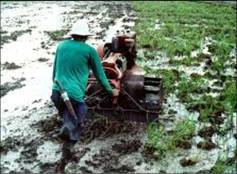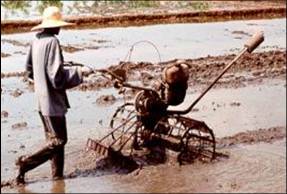
Also called the walking tractor, iron buffalo, steel buffalo or hand tractor, 2-wheel tractors are used in many rice producing countries These tractors have a forward mounted engine which is counter-balanced by the equipment attached behind the two drive wheels. The operator walks behind the tractor.
2-wheel tractors are normally powered by 6-12 kW gasoline or diesel engines and are fitted with either rubber tires or steel cage wheels. Rubber tires are commonly used for dry land plowing and transportation. Cage wheels are necessary for all wet workings. Most makes of 2-wheel tractors incorporate an independent drive clutch as well as individual steering clutches or brakes. Three forward and one reverse working gear are most common.

2-wheel tractors are used for land preparation. This includes plowing, land leveling, transportation and pumping water. The attachments used with 2-wheel tractors are the moldboard plough, the disc plough, harrows and rotovators.
The advantages of 2-wheel tractors are:
- multi-purpose vehicle
- operate in harder conditions than animals or humans
- operate in both wet and dry conditions
- fairly simple mechanical design
The disadvantages are:
- cost of owning and operating
- operator fatigue, although ride-on versions are now available.
The cost of a 2-wheel tractor ranges from $US110 to $US270 per kW depending on the make of the engine. One 9 kW walking tractor with two operators is capable of plowing one hectare in one day. While fuel usage depends on engine size and working conditions, fuel consumption will range from 2 to 5 liters per hour.